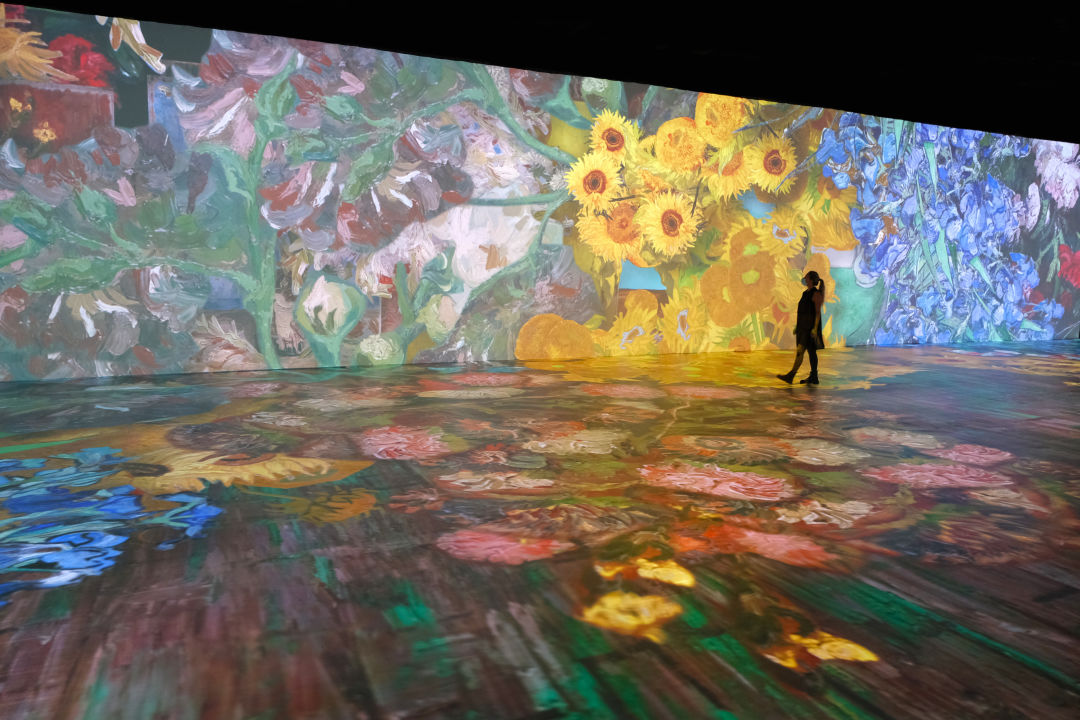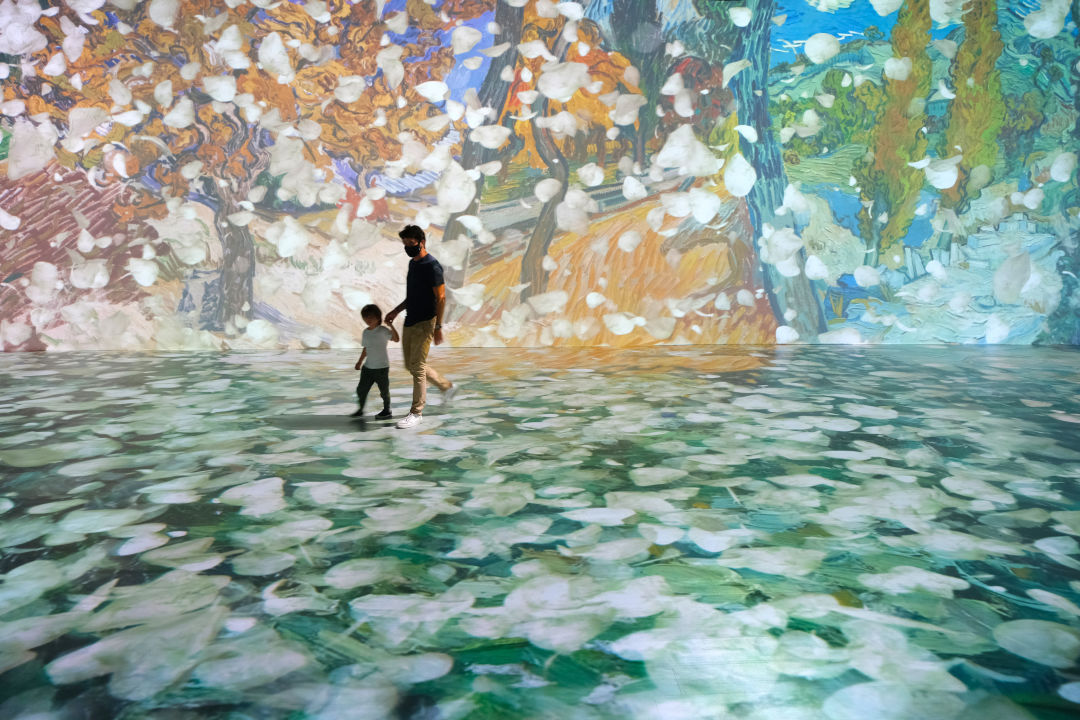Portland's Finally Getting Its Own Immersive Van Gogh Show

Flowers projected onto the walls at Beyond Van Gogh.
Image: Courtesy of Beyond Van Gogh
To see the work of famed artist Vincent Van Gogh in Portland up close, you ordinarily must go to the Portland Art Museum, where a single, much-prized early work by the Netherlands’ favorite son hangs in the museum’s gallery of modern and contemporary art.
The painting, which depicts an ox pulling a cart heaped with dung, all in moody shades of brown and grey, doesn’t immediately scream Van Gogh—there’s none of the exuberant overflow of color that launched a million “Starry Night” dorm room posters and mouse pads.
For that, you’ll have to make your way instead to the Oregon Convention Center, where in Exhibit Hall E—looking quite different from its incarnation as a mass vaccination clinic last winter—you’ll find “Beyond Van Gogh,” one of several competing immersive Van Gogh experiences crisscrossing the country at present, but the first to make it to Portland.
(Perhaps you are wondering, as I did, what Vincent Van Gogh ever did to deserve all this? It’s partly because almost all of his work is readily available in the public domain, and partly because of the impossibly vapid, oo-la-la heroine of Netflix’s Emily in Paris.)
Without seeing all the Van Gogh exhibits, it’s difficult to determine where Portland’s ranks, but a cursory glance at online reviews suggests that ours is on the ever-so-slightly jankier end of the scale, at least if what you are looking for are bells and whistles in the form of VR headsets that make it seem as though you too are strolling through a field of sunflowers in the south of France. We aren’t getting the selfie-ready recreation of Van Gogh’s bedroom at Arles, nor set design from the team responsible for Hamilton on Broadway. (There is tiered pricing, but it’s not entirely clear what the premium tickets will net you, beyond a chance to cut to the front of the line and stay longer: “Good question!” said my media host. “I think maybe swag?”)
Instead, your journey begins in the first of three “galleries,” where you snake your way through backlit panels with biographical information about Van Gogh, quotes pulled from his extensive correspondence with his brother Theo, analysis of his artistic techniques and—curiously—empty frames painted sunflower yellow, strategically placed for Instagram bait.
Next, you transition into what’s rather grandly billed as “the waterfall room” which is a bit like gazing upon a giant screensaver that is somehow projected onto your feet. (The effect here is somewhat blunted by the light show being on only one of four walls and the floor, making it difficult to forget that you are still, in fact, in Exhibit Hall E. The goal is to give you a sense of the colors and brush strokes used by Van Gogh, though it reminded me more of peering through a microscope at prepared slides of ameobas and such during high school science.)
Finally, the main event: a giant room, with animated, ever-changing images of Van Gogh’s greatest hits projected onto all four walls and the floor. Curator Fanny Curat has arranged this room so the works appear in chronological order, but you can walk in at any point and pick up the thread.
At first, the experience is a little jarring. The movement of it all takes some getting used to—and did Van Gogh himself just wink at you? (Yes, yes, he did, through the wonders of digital manipulation, which also makes it look as though smoke is rising from his pipe.) The soundtrack is mainly there for background noise—at one point I recognized an ersatz version of Simon and Garfunkel’s “America,” which felt like a choice. The whole experience can feel like watching a short in an IMAX theater; it lacks the energy, cheekiness and interactivity of the best installations at Portland’s annual Winter Light Festival.

Cherry blossoms whirl on the walls and floor during "Beyond Van Gogh."
Image: Courtesy of Beyond Van Gogh
But after 20 months and counting of a pandemic-narrowed life, who among us wouldn’t like to be transported to the streets of Paris or the south of France? I surrendered when the entire room filled with Van Gogh’s images of flowers in jugs, many painted when he was too poor to pay a model. Those familiar jars of sunflowers and irises are the gateway to the coolest effect of "Beyond Van Gogh," when the walls and floor of the room are covered by a floof of falling cherry blossoms. It might not have much to do with our one-eared hero, but it sure is digital-pretty, a Google Doodle writ largest.
Immersive art and digital installations like these aren't reserved for one-off like "Beyond Van Gogh." Sara Krajewski, the Robert and Mercedes Eichholz Curator of Modern and Contemporary Art at the Portland Art Museum, points out that the museum has been working closely with the Portland-based collective Mobile Projection Unit. The difference is that their work is commissioned and created specifically for spaces in and around Portland, not adapted in ways that Van Gogh could never have imagined.
"What I appreciate about how artists can use projection in particular is how they can make the familiar unfamiliar, and expand projection onto multiple surfaces to change our perception of a given space and animate it," Krajewski says. "They are putting in the work to create a visual experience from their own imaginations."
Mobile Projection Unit's work has been displayed on the exterior of the museum's buildings, for free, but inside, there's more experimentation with digital/virtual reality installations coming, Krajewski says—including the recently acquired video sculpture "Power Plants" by German artists and filmmaker Hito Steyerl, which is soon to be on display at PAM.
On the touring end of things, Curat—who would love the immersive art experience to literally go beyond Van Gogh to even more genre-pushing artists, from Georgia O’Keeffe to Francisco Goya—says Van Gogh is the perfect subject for immersion right now.
“During the pandemic, everyone is and was in crisis,” she says. “To hear of [Van Gogh] going through these challenges and yet producing a work of beauty is inspiring. He was cooped up in an asylum cell—as we have all been cooped up—when he painted ‘Starry Night.’”
Speaking of "Starry Night," that blockbuster features prominently, as you might expect, both on the walls and on the mugs and magnets for sale in the obligatory pop-up gift shop that awaits you at the end of the experience. I did not buy anything—but I did decide that it was time to pay a visit to the Portland Art Museum, for another long look at "The Ox Cart."
Beyond Van Gogh
10 a.m–10 p.m. Mon–Sun, Nov 19–Jan 9, $25–94, Oregon Convention Center




